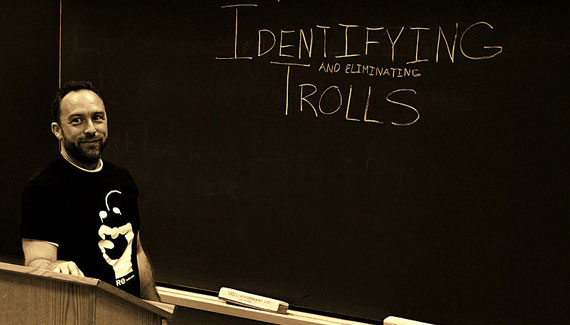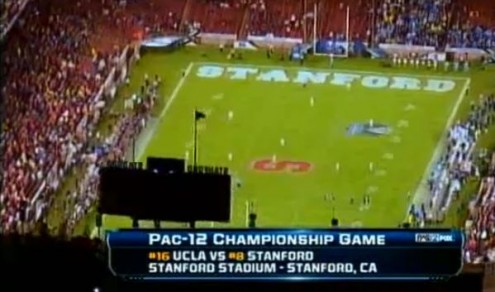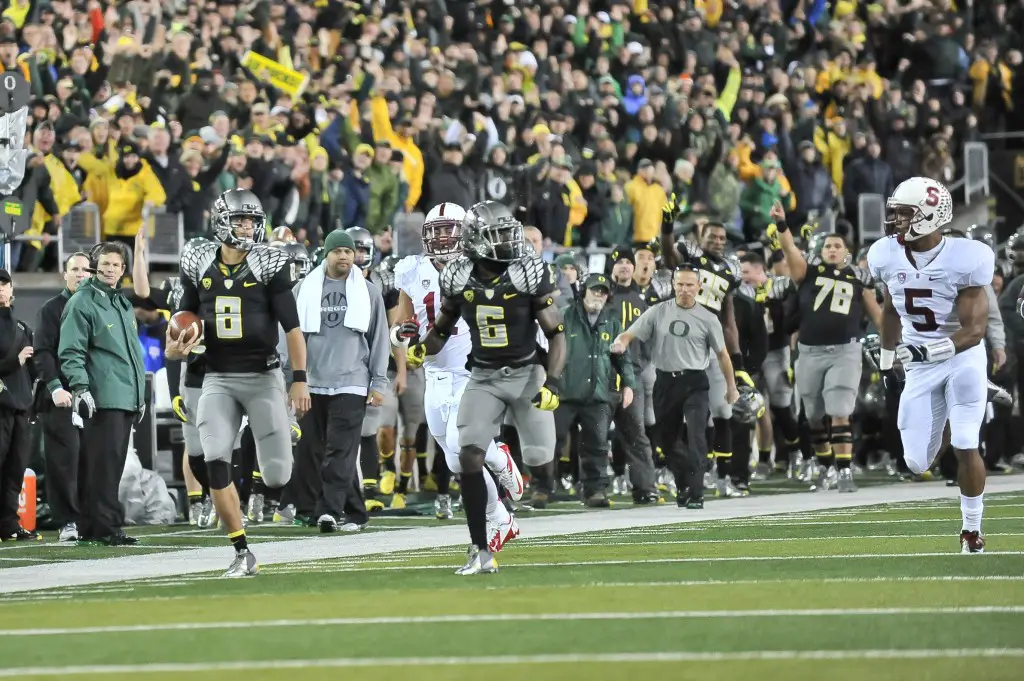Wikimedia Commons
In the modern lexicon, there isn’t a word that reveals one’s level of online presence better than the word “troll.” (For those unfamiliar with the term, check out Wikipedia’s page on the subject. If you are still unclear on the definition, find the person in your life that spends the most time on Reddit and have them explain it to you.) While the term itself was born on the internet to describe annoying web behavior, trolling isn’t limited to just the online medium. Trolling behavior can be done anywhere: Online, in print and even in person.
Last week we got a textbook example of trolling from a Portland-based newspaper columnist, whose article offered up an anonymous letter from a former Oregon player that was highly critical of the Oregon fan base. By running the letter, the former player got to sling mud and inject his comments into the public discussion without having to even give us his name, while the columnist was able to drive web traffic and initiate a conversation without having to stand behind it as his own words. The end result was character assassination of a particular group, without either party being subject to any rebuttal. Classic troll behavior!
Sports Illustrated took its turn at trolling Oregon later in the week, deciding that of the three elite teams with three high-level quarterbacks who are head-and-shoulders above the rest of college football, they should focus their famed SI cover jinx on Oregon the week before its biggest game of the season. The tagline? How “Oregon Redefined West Coast Football, Now It’s Time To Conquer America”.
Of course, the only article in the issue about Oregon doesn’t relate to the tagline itself, instead they chose to focus on something about the Oregon-Stanford “rivalry,” or lack thereof. Stanford’s presence in Oregon’s cover story makes sense, because injecting yourself into a conversation you don’t belong is the epitome of trolling. Stanford’s program discussed alongside Oregon in an article about redefining West Coast football would fit, once you realize that Stanford’s program is the “trollingest” in college football.
If you haven’t read the Sports Illustrated article, it breaks down how Oregon and Stanford got to their current place in college football while wondering why there isn’t a rivalry between the two schools; presenting the theory that it has to do with the two programs’ recent ascents to college football’s elite. Outsiders make the assumption that because the teams have split their last four games and both have been to BCS bowl games in three consecutive seasons (for Oregon, four) that these teams should be bitter rivals, but the recent ascent is Stanford’s, not Oregon’s.
What would have been, to someone with any familiarity of the history between the two teams, is that the reason the rivalry doesn’t exist is largely based on two reasons:
1) Stanford Hasn’t Proven it is on Oregon’s Level
In the past 15 seasons, Stanford has defeated Oregon just three times. Three is also how many more conference championships Oregon has won than the Cardinal (5-2) in that span. But both seasons (1999, 2012) the Cardinal won the Pac-10/12 and Oregon finished the season ranked higher than Stanford. In fact, Stanford hasn’t defeated the Ducks and finished the season with a better record or ranking since 1996. Stanford might be able to sneak out a big win or two, but it still hasn’t shown that it can ‘own’ the conference. Losing to schools on the fringe of bowl eligibility such as Washington, in 2012, and Utah this year, doesn’t help establish the reputation of “an elite program.”
2) Stanford Fans Don’t Care About Football
You don’t have to win football games to hate another team. Washington and Oregon State fans do just fine hating Oregon, and vice-versa, despite extended periods of mediocrity at various times for all the programs in those rivalries. If Stanford wanted to hate Oregon, it would. It doesn’t because their fans don’t care about football.
If they cared, then in the past they would have sold out their season tickets. This year is the first time in school history they have done so. Apparently, going 23-3 and playing in back-to-back BCS bowls in 2010 and 2011, wasn’t enough success for Stanford fans to be bothered with buying tickets. No, it had to win the Rose Bowl, advertise on TV, and having possibly the most attractive home schedule (San Jose State, ASU, UCLA, Washington, Oregon, Cal, and Notre Dame) in college football, to do so. When a team gets its top four conference opponents all at home in a single year, and their second-worst home game from an appeal standpoint is a rivalry game, that is an amazing schedule.
Not that playing a marquee opponent in a big game matters to Stanford fans. With a chance to win the conference and maybe head to the Rose Bowl is a possibility — not a certainty – Stanford fans still couldn’t be bothered to fill their stadium for last year’s Pac-12 Championship Game. Only 31,000 fans showed up to see the first conference title in 13 years, which also happened to be the team’s most poorly attended game since a 2010 match-up against Sacramento State. I guess Stanford fans clearly don’t have time for “possibilities,” they only have time for “winners.” Loyal fans, through thick and thin, that lot.
It’s not just me saying this. The indifference of Stanford fans, particularly its student body, is well-chronicled. Andrew Luck once told a story on College GameDay about playing Washington on the road, only to return to his dorm the next day, with a fellow floormate asking where he was. When he told them he was in Seattle, they asked “for what?” — completely unaware of their game with the Huskies, or that he played football at all. He’s not the only one with those stories. Former Cardinal center Chase Beeler has said, “[When I got here] there was just very little familiarity or awareness of football among anyone in the student population . . ..” – showing students at Stanford, the ones who are going to comprise future alumni, couldn’t care less.
It’s not as though this is a program that just picked up football. From Pop Warner to Fielding Yost through Bill Walsh and Denny Green, Stanford has had its share of big-time coaches. Big-time players, too, such as John Elway, as was 1970 Heisman Trophy winner Jim Plunkett. The school has played in 13 Rose Bowls. But with all that success, somehow the student body didn’t discover football until the last few years.
More likely, they didn’t “discover” Stanford football previously, because the identity of the team and its classic athletic style never fit them, until now. Instead of being a football program that excites, it is now one that trolls, and that is a role this student body has embraced.
While the rest of the Pac-12 is trying to redefine college football through a variety of exciting, unique offenses, Stanford seems only interested in inflicting its brand of nihilistic, regressive football, in the vain hope of returning the sport to a time that predates television. Or as SBNation’s Spencer Hall described them: Stanford is “the team the Soviets would have built.”
Much like the disorganized vestiges of its marching band, Stanford doesn’t want any part of performing in a way that’s seen as beautiful, instead choosing to inflict its chaos on those who want to enjoy football through any lens of conventional enjoyment that doesn’t make it a cluttered, disgusting mess.
Just look at the misery they have brought to the Pac-12 and to college football. Two of Stanford’s wins (2001, 2012) kept Oregon out of the national title games, while providing no other nationally-worthy candidate from the conference. Those years gave us Miami-Nebraska and Alabama-Notre Dame, considered two of worst championship games in BCS history. Meanwhile, the seasons Stanford was good enough to actually beat all its opponents other than Oregon and play for the title itself, it couldn’t materialize enough of a game plan to even stay competitive with the Ducks. Stanford doesn’t want anyone in the Pac-12 to win – not Oregon, and definitely not even itself.
Stanford doesn’t play to make football fun; they play to ruin it for everyone else. It loses to Utah and struggles through games with Oregon State and Army, yet somehow maintains a top-five ranking solely on the potential that it could beat Oregon, and if it does, will only continue to muddle the Pac-12’s reputation. In the mall of college football, if 11 Pac-12 teams are trying to take the “up” escalator to the top, Stanford is the one team trying to force the same escalator to go down. Sure, they are already near the top, but their goal isn’t to stay there, it’s to get in the way of anyone trying to climb above them.
The reputation and the success of the Ducks, and the conference as a whole, is at stake. Don’t let the trolls win, Ducks. Beat Stanford!
Related Articles:
Chip Kelly Update: Everything's Good Again ...
Chip Kelly Update: Wailing and Gnashing of Teeth
Shock and Awe -- The Oregon Ducks' Football Hangover Effect
Despite Lopsided Score, Georgia State "Never Stopped Believing"
Hope Springs Eternal for Ducks
Incompetent Pac-12 Officials: How Do You Miss ALL of THIS?
Nathan Roholt is a senior writer and managing editor emeritus for FishDuck. Follow him on Twitter @nathanroholt. Send questions/feedback/hatemail to nroholtfd@gmail.com.




